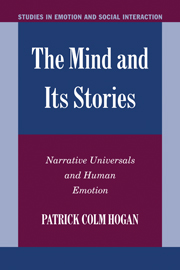Book contents
- Frontmatter
- Contents
- Acknowledgments
- The Mind and Its Stories
- Introduction: Studying Narrative, Studying Emotion
- 1 Literary Universals
- 2 Emotion and Suggestion: Lexical Processes in Literary Experience
- 3 Four Hypotheses on Emotion and Narrative
- 4 Writing Beyond the Ending: A Problem of Narrative, Empathy, and Ethics
- 5 Extending the Theory: Emotion Prototypes, Narrative Junctures, and Lyric Poetry
- 6 Testing, Revision, and the Program of Research in Narrative Universals: Ainu Epic and the Plot of Sacrifice
- 7 The Structure of Stories: Some General Principles of Plot
- Afterword: From the Emotional Nature of Narrative to the Narrative Nature of Emotion
- Works Cited
- Index
- Titles in the series
7 - The Structure of Stories: Some General Principles of Plot
Published online by Cambridge University Press: 11 July 2009
- Frontmatter
- Contents
- Acknowledgments
- The Mind and Its Stories
- Introduction: Studying Narrative, Studying Emotion
- 1 Literary Universals
- 2 Emotion and Suggestion: Lexical Processes in Literary Experience
- 3 Four Hypotheses on Emotion and Narrative
- 4 Writing Beyond the Ending: A Problem of Narrative, Empathy, and Ethics
- 5 Extending the Theory: Emotion Prototypes, Narrative Junctures, and Lyric Poetry
- 6 Testing, Revision, and the Program of Research in Narrative Universals: Ainu Epic and the Plot of Sacrifice
- 7 The Structure of Stories: Some General Principles of Plot
- Afterword: From the Emotional Nature of Narrative to the Narrative Nature of Emotion
- Works Cited
- Index
- Titles in the series
Summary
One of the major contentions of the preceding chapters is that narratives are generated, not by complexes of abstract conditions, but by much more concrete prototypes. Obviously, there are exceptions to this. If a playwright determines to follow a five-act structure or an epicist accepts the notion that a heroic poem should begin in medias res, his/her work will be organized in part by reference to abstract conditions. However, the application of such abstract conditions is very limited. Indeed, one might argue that even in these cases we are mistaken in attributing a primary generative function to the general principles (“Organize the play into five acts,” “Begin in the middle of things”). For any author, these general principles are bound up with standard types and with particular instances. If I write an epic in twelve books, I have Milton and Virgil in mind. My conception of the twelve-book structure is shaped by their poems. In other words, here too my work is generated from more concrete precedents – in this case, exempla.
Nonetheless, to say that narrative is most importantly derived from prototypes (and exempla) is not to deny the possibility of making general statements about narratives. Indeed, to say that narratives are generated from emotion prototypes is one such general statement. The purpose of this chapter is to articulate and develop some further generalizations about narrative, as they derive from the preceding analyses and bear on our understanding of the relation between narrative and emotion.
- Type
- Chapter
- Information
- The Mind and its StoriesNarrative Universals and Human Emotion, pp. 202 - 238Publisher: Cambridge University PressPrint publication year: 2003



